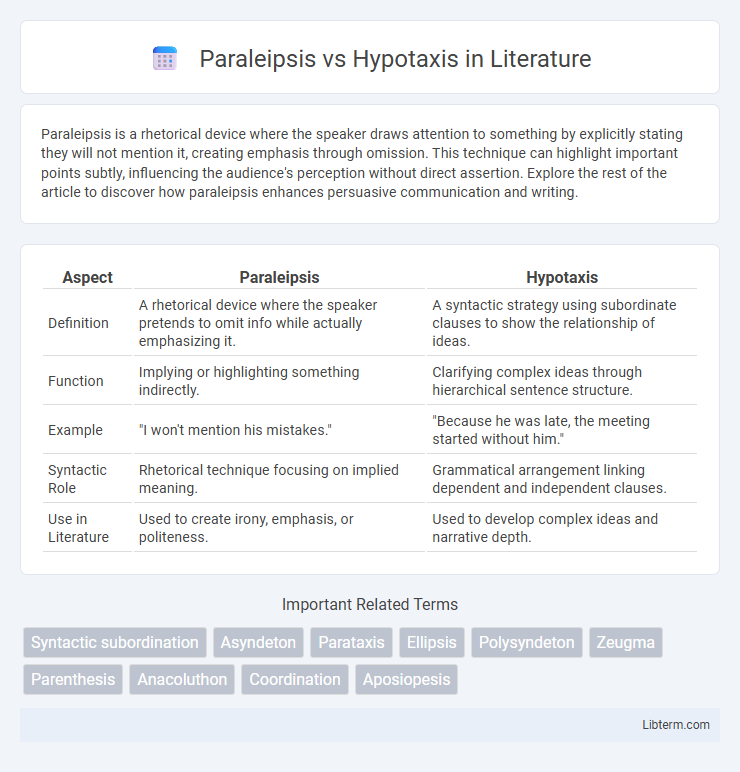Paraleipsis is a rhetorical device where the speaker draws attention to something by explicitly stating they will not mention it, creating emphasis through omission. This technique can highlight important points subtly, influencing the audience's perception without direct assertion. Explore the rest of the article to discover how paraleipsis enhances persuasive communication and writing.
Table of Comparison
| Aspect | Paraleipsis | Hypotaxis |
|---|---|---|
| Definition | A rhetorical device where the speaker pretends to omit info while actually emphasizing it. | A syntactic strategy using subordinate clauses to show the relationship of ideas. |
| Function | Implying or highlighting something indirectly. | Clarifying complex ideas through hierarchical sentence structure. |
| Example | "I won't mention his mistakes." | "Because he was late, the meeting started without him." |
| Syntactic Role | Rhetorical technique focusing on implied meaning. | Grammatical arrangement linking dependent and independent clauses. |
| Use in Literature | Used to create irony, emphasis, or politeness. | Used to develop complex ideas and narrative depth. |
Understanding Paraleipsis: Definition and Usage
Paraleipsis is a rhetorical device where a speaker or writer brings up a subject by explicitly stating they will not mention it, thereby drawing attention to it indirectly. This technique creates emphasis and can introduce irony or subtlety in communication by highlighting information while pretending to omit it. Understanding paraleipsis involves recognizing its strategic use in literature, politics, and everyday discourse to influence audience perception through implied emphasis.
What is Hypotaxis? Key Characteristics
Hypotaxis is a grammatical structure that uses subordinate clauses to show the relationship of dependence between ideas, creating a hierarchy within sentences. Key characteristics include the use of conjunctions like "because," "although," and "when," which link main clauses to subordinate clauses, emphasizing logical connections and clarity. This structure contrasts with paraleipsis, which relies on implied or omitted information instead of explicit subordinate relationships.
Paraleipsis vs. Hypotaxis: Core Differences
Paraleipsis emphasizes omission by stating something will not be mentioned while actually drawing attention to it, creating an implicit focus through strategic silence. Hypotaxis involves the use of subordinated clauses that structure sentences with clear hierarchy and logical relationships, enhancing clarity and complexity in expression. The core difference lies in paraleipsis employing omission as a rhetorical device, whereas hypotaxis relies on syntactic subordination to organize ideas explicitly.
Historical Origins and Literary Context
Paraleipsis traces its roots to classical rhetoric, prominently used by Cicero and Quintilian to emphasize points by professing to omit them, thereby engaging audiences through strategic understatement. Hypotaxis, originating in ancient Greek rhetoric and refined in Latin literature, is characterized by complex sentence structures using subordinating conjunctions to create clear hierarchical relationships between clauses, evident in works by authors like Homer and Virgil. Both devices serve distinct literary functions: paraleipsis manipulates emphasis and omission for persuasive effect, while hypotaxis organizes ideas logically and syntactically to enhance clarity and depth.
Semantic Implications in Rhetoric
Paraleipsis emphasizes meaning by deliberately omitting details to draw attention while implying significance, creating a layered rhetorical effect that engages the audience's inferential reasoning. Hypotaxis structures complex ideas through subordination, clarifying semantic relationships and enhancing logical coherence in argumentation. The semantic implications of paraleipsis foster subtle persuasion by suggestion, whereas hypotaxis achieves precise meaning through explicit hierarchical connections.
Effect on Narrative Structure and Clarity
Paraleipsis creates emphasis through strategic omission, allowing readers to infer meaning and engage more actively in the narrative, which can introduce subtlety but risk ambiguity. Hypotaxis structures ideas hierarchically with complex, subordinated clauses, enhancing clarity and logical flow by explicitly showing relationships between concepts. Balancing paraleipsis and hypotaxis effectively influences narrative depth and reader comprehension by managing the tension between implied meaning and explicit explanation.
Common Examples of Paraleipsis in Literature
Paraleipsis is a rhetorical device where the speaker or writer brings up a subject by either denying it or pretending to pass over it, often highlighting something indirectly. Common examples in literature include Shakespeare's use of paraleipsis in "Julius Caesar," where Antony repeatedly claims he "comes to bury Caesar, not to praise him," while actually praising him. Another notable instance appears in Mark Antony's funeral speech, subtly emphasizing Caesar's virtues while ostensibly withholding praise, showcasing paraleipsis as a powerful tool for irony and emphasis.
Illustrative Examples of Hypotaxis in Writing
Hypotaxis in writing involves the use of subordinate clauses to create complex, layered sentences that clearly show the relationship between ideas, such as in the sentence, "Because she was tired, she went to bed early." This contrasts with paraleipsis, which emphasizes omission or deliberate omission of details. Examples of hypotaxis enrich narrative depth by linking cause and effect, time, or condition, providing clarity and coherence to the text.
When to Use Paraleipsis or Hypotaxis
Paraleipsis is used when a speaker or writer wants to emphasize a point by stating they will not mention something, thereby drawing attention indirectly and creating a rhetorical effect. Hypotaxis, characterized by the use of subordinate clauses, is preferred when clarity, logical relationships, and detailed explanation are necessary, facilitating complex and precise communication. Choose paraleipsis to imply meaning subtly and hypotaxis to structure information clearly and hierarchically in formal or analytical contexts.
Paraleipsis and Hypotaxis in Modern Communication
Paraleipsis, the rhetorical device of emphasizing something by professing to omit it, enhances persuasive impact in modern communication by subtly directing audience attention without overt assertion. Hypotaxis, characterized by complex sentence structures with subordinated clauses, facilitates clarity and depth in digital and academic discourse by explicitly showing relationships between ideas. Both techniques manipulate emphasis and coherence, but paraleipsis leverages indirect suggestion, while hypotaxis relies on syntactic hierarchy for effective message delivery.
Paraleipsis Infographic

 libterm.com
libterm.com